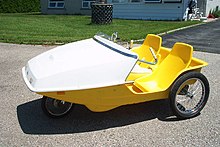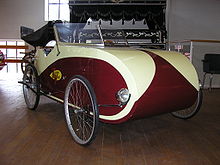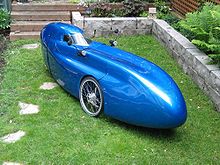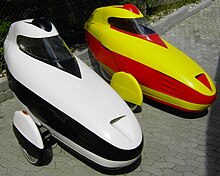Velomobile
A velomobile (/ˈvɛloʊmoʊˌbil/); velomobiel, velo, or bicycle car is a human-powered vehicle (HPV) enclosed for aerodynamic advantage and/or protection from weather and collisions.
[1] Velomobiles are similar to recumbent bicycles, pedal go-karts and tricycles, but with a full fairing (aerodynamic or weather protective shell) and are not to be confused with purpose-built mobiles for speed records.
Depending on the configuration of the velomobile there may be any number of idler pulleys, and chaintubes[6] along the drive train to manage and protect the chain.
Positive features, such as easily adjustable and comfortable seats, independent pedalling for both passenger and driver, adequate cargo space and relatively good weather protection, could not overcome the negative features, such as a complex, heavy and badly spaced three-speed gear box, ineffective brakes, and pedals that slid on sleeve bearings on steel shafts, which made it difficult to use as an everyday vehicle.
In the 1970s, Carl-Georg Rasmussen rediscovered Fantomen; he redesigned it and in 1983 started selling a production version called Leitra.
Another modern design is the Alleweder [de], using aluminum sheet formed and riveted to make the fairing and the structure in one piece.
Another common modern design is a monocoque shell, often made of fiber-reinforced plastic or "FRP", plus sub-frames of welded aluminum tubes.
A wide range of fibers may be used, but those which reduce weight while retaining strength and toughness often increase the price significantly—e.g., a premium of 1000 Euros to save 3 kg.
But despite the cost and other issues, the aerodynamic and weight advantages mean that (as of 2017) monocoque FRP is a common way to build velomobiles.
For example, some emphasize aerodynamics and light weight to improve average speed, even if cost, ease of entry/exit, comfort, and other "practical vehicle" attributes are reduced.
By analogy, many automobile makers make performance cars with limited seating and cargo and worse emissions and fuel economy.
In contrast, other velomobile designs sacrifice performance features in order to improve cost, entry/exit, comfort, carrying capacity, and so on.
The C5 was a delta trike (one front, two rear wheels) with electric assist designed to be mass-produced and sold for a low price.
A concept and a potential assessment concerning low-cost velomobiles for daily short trips as well as strategies for reaching a critical lot size for mass production was the subject of a research project called RegInnoMobil.
For a given terrain, the added weight demands lower gearing and makes the velomobile slower climbing hills than its unfaired counterpart.
In turn, aerodynamic velomobiles use a laid-back or recumbent riding position, with the rider's head much lower than on regular bicycles.
"Wind steer" can be a safety issue and may also hurt performance, as a serpentine path is longer and thus slower than a straight line.
A larger fairing also hurts weight and has more skin drag), but as with time-trial bicycles, worse aerodynamics but better handling is sometimes a good trade-off.
However, to retain stability against tipping (both cornering and cross-winds), the wheel track needs to be wider than a comparable velomobile with a low seating position.
Many velomobiles have vents and ducts which allow cooling while keeping out water; and the ducts/vents may be closed or covered in cold weather so the rider can stay comfortable even without a secondary heat source.
In warm and hot weather, the fairing provides sun protection, but blocks the rider from cooling air, and so may be much warmer for a given level of effort.
Although sharp steering is not needed at speed, many aerodynamic velomobiles have a much worse turning circle than an equivalent unfaired cycle.
At the same time, two-wheel streamliners require a way to stay upright when stopped and at very low speed, and are more sensitive to blowing over in cross-winds.
are used as well due to design constraints in velomobile models with one-sided rear wheel mounting like the Quest, Strada and Mango or front wheel drive in the Velayo, or better efficiency by using the multiple speeds of the chain drive or internal geared hubs (e.g. Rohloff 14 speed hub).
[citation needed] While an electric-assist unit does add extra weight to the velomobile,[21] it is somewhat offset by the flexibility it also provides, especially during hill climbs and stop-and-go traffic.
[citation needed] In events like the RACV Energy Breakthrough and the Fraser Coast Technology Challenge, there are entire categories dedicated to electric and other hybrid powered velomobiles.
The Veemo, now produced by ENVO Drive Systems, is a semi-enclosed, pedal-electric velomobile designed to offer a practical and eco-friendly alternative for urban commuting.
The Veemo differs from many other velomobiles by focusing on comfort for city commuting, rather than minimizing drag for racing purposes, instead relying on the electric assist drivetrain to compensate for the added weight of the enclosed vehicle compared to a typical bicycle.
With a growing DIY-community[citation needed] and an increasing interest in environmentally friendly "green energy", some hobbyists have endeavored to build their own velomobiles from kits, sourced components, or from scratch.
Probably the most built velomobile kits were the various models of the Alleweder made from prefabricated aluminium sheet metal due to its affordable price.









